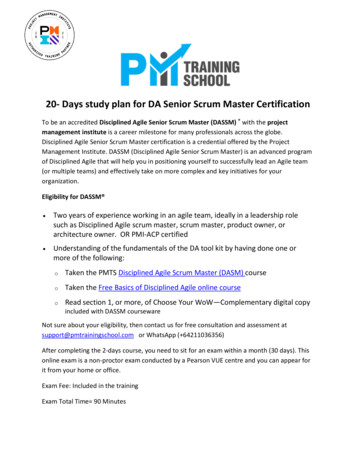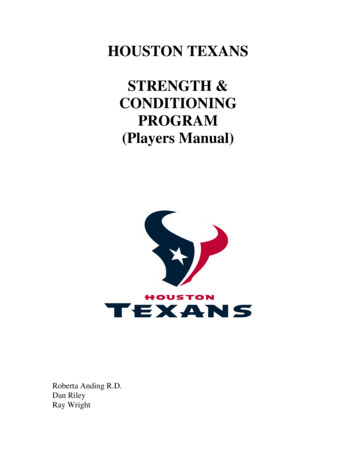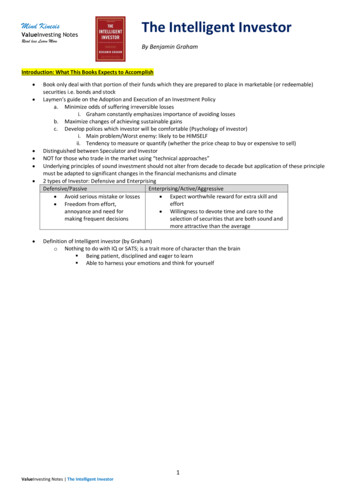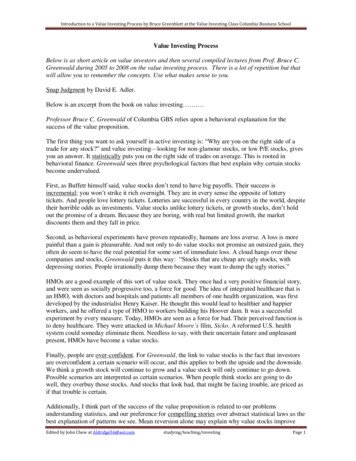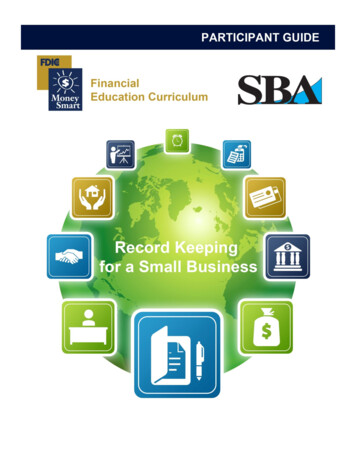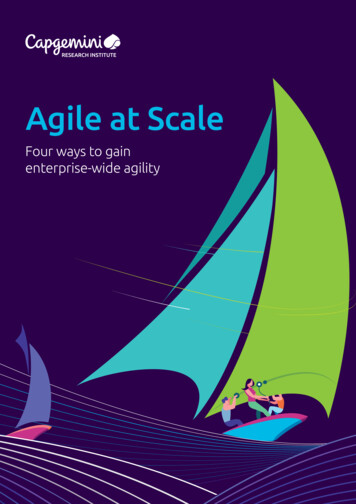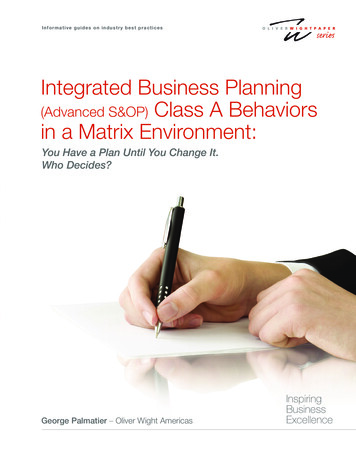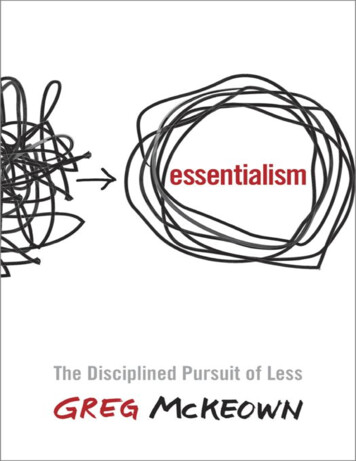
Transcription
Copyright 2014 by Greg McKeownAll rights reserved.Published in the United States by Crown Business, an imprint of the Crown PublishingGroup, a division of Random House LLC, a Penguin Random House Company, New York.www.crownpublishing.comCROWN BUSINESS is a trademark and CROWN and the Rising Sun colophon are registeredtrademarks of Random House LLC.Library of Congress Cataloging-in-Publication DataMcKeown, Gregpages cm1. Choice (Psychology) 2. Decision making. 3. EssentialismBF611.M455 2014153.8/3 2012001733ISBN 978-0-8041-3738-6eBook ISBN 978-0-8041-3739-3Illustrations and jacket design by Amy Hayes Stellhorn and her team at Big Monocle incollaboration with Maria Elias.v3.1
DEDICATED TOANNAGRACEEVEJACKAND ESTHERYOU PERSONIFY EVERYTHINGTHAT IS ESSENTIAL TO ME.
CONTENTSCoverTitle PageCopyrightDedication1. The EssentialistPart I: Essence: What is the core mind-set of an Essentialist?2. CHOOSE: The Invincible Power of Choice3. DISCERN: The Unimportance of Practically Everything4. TRADE-OFF: Which Problem Do I Want?Part II: Explore: How can we discern the trivial many from thevital few?5. ESCAPE: The Perks of Being Unavailable6. LOOK: See What Really Matters7. PLAY: Embrace the Wisdom of Your Inner Child8. SLEEP: Protect the Asset9. SELECT: The Power of Extreme CriteriaPart III: Eliminate: How can we cut out the trivial many?10. CLARIFY: One Decision That Makes a Thousand11. DARE: The Power of a Graceful “No”12. UNCOMMIT: Win Big by Cutting Your Losses13. EDIT: The Invisible Art14. LIMIT: The Freedom of Setting Boundaries
Part IV: Execute: How can we make doing the vital few thingsalmost e ortless?15. BUFFER: The Unfair Advantage16. SUBTRACT: Bring Forth More by Removing Obstacles17. PROGRESS: The Power of Small Wins18. FLOW: The Genius of Routine19. FOCUS: What’s Important Now?20. BE: The Essentialist LifeAppendixLeadership EssentialsNotesAcknowledgmentsTaking Essentialism Beyond the Page
CHAPTER 1The EssentialistTHE WISDOM OF LIFE CONSISTS IN THE ELIMINATION OF NON-ESSENTIALS.—Lin YutangSam Elliot* is a capable executive in Silicon Valley who foundhimself stretched too thin after his company was acquired by alarger, bureaucratic business.He was in earnest about being a good citizen in his new role so hesaid yes to many requests without really thinking about it. But as aresult he would spend the whole day rushing from one meeting andconference call to another trying to please everyone and get it alldone. His stress went up as the quality of his work went down. Itwas like he was majoring in minor activities and as a result, hiswork became unsatisfying for him and frustrating for the people hewas trying so hard to please.In the midst of his frustration the company came to him ando ered him an early retirement package. But he was in his early 50sand had no interest in completely retiring. He thought brie y aboutstarting a consulting company doing what he was already doing. Heeven thought of selling his services back to his employer as aconsultant. But none of these options seemed that appealing. So hewent to speak with a mentor who gave him surprising advice: “Stay,but do what you would as a consultant and nothing else. And don’ttell anyone.” In other words, his mentor was advising him to doonly those things that he deemed essential—and ignore everythingelse that was asked of him.The executive followed the advice! He made a daily commitmenttowards cutting out the red tape. He began saying no.
He was tentative at rst. He would evaluate requests based on thetimid criteria, “Can I actually ful ll this request, given the time andresources I have?” If the answer was no then he would refuse therequest. He was pleasantly surprised to nd that while people wouldat rst look a little disappointed, they seemed to respect hishonesty.Encouraged by his small wins he pushed back a bit more. Nowwhen a request would come in he would pause and evaluate therequest against a tougher criteria: “Is this the very most importantthing I should be doing with my time and resources right now?”If he couldn’t answer a de nitive yes, then he would refuse therequest. And once again to his delight, while his colleagues mightinitially seem disappointed, they soon began to respect him more forhis refusal, not less.Emboldened, he began to apply this selective criteria toeverything, not just direct requests. In his past life he would alwaysvolunteer for presentations or assignments that came up last minute;now he found a way to not sign up for them. He used to be one ofthe rst to jump in on an e-mail trail, but now he just stepped backand let others jump in. He stopped attending conference calls thathe only had a couple of minutes of interest in. He stopped sitting inon the weekly update call because he didn’t need the information.He stopped attending meetings on his calendar if he didn’t have adirect contribution to make. He explained to me, “Just because Iwas invited didn’t seem a good enough reason to attend.”It felt self-indulgent at rst. But by being selective he boughthimself space, and in that space he found creative freedom. Hecould concentrate his e orts on one project at a time. He could planthoroughly. He could anticipate roadblocks and start to removeobstacles. Instead of spinning his wheels trying to get everythingdone, he could get the right things done. His newfound commitmentto doing only the things that were truly important—and eliminatingeverything else—restored the quality of his work. Instead of makingjust a millimeter of progress in a million directions he began togenerate tremendous momentum towards accomplishing the thingsthat were truly vital.
He continued this for several months. He immediately found thathe not only got more of his day back at work, in the evenings he goteven more time back at home. He said, “I got back my family life! Ican go home at a decent time.” Now instead of being a slave to hisphone he shuts it down. He goes to the gym. He goes out to eat withhis wife.To his great surprise, there were no negative repercussions to hisexperiment. His manager didn’t chastise him. His colleagues didn’tresent him. Quite the opposite; because he was left only withprojects that were meaningful to him and actually valuable to thecompany, they began to respect and value his work more than ever.His work became ful lling again. His performance ratings went up.He ended up with one of the largest bonuses of his career!In this example is the basic value proposition of Essentialism: onlyonce you give yourself permission to stop trying to do it all, to stopsaying yes to everyone, can you make your highest contributiontowards the things that really matter.What about you? How many times have you reacted to a requestby saying yes without really thinking about it? How many timeshave you resented committing to do something and wondered,“Why did I sign up for this?” How often do you say yes simply toplease? Or to avoid trouble? Or because “yes” had just become yourdefault response?Now let me ask you this: Have you ever found yourself stretchedtoo thin? Have you ever felt both overworked and underutilized?Have you ever found yourself majoring in minor activities? Do youever feel busy but not productive? Like you’re always in motion, butnever getting anywhere?If you answered yes to any of these, the way out is the way of theEssentialist.
The Way of the EssentialistDieter Rams was the lead designer at Braun for many years. He isdriven by the idea that almost everything is noise. He believes veryfew things are essential. His job is to lter through that noise untilhe gets to the essence. For example, as a young twenty-four-year-oldat the company he was asked to collaborate on a record player. Thenorm at the time was to cover the turntable in a solid wooden lid oreven to incorporate the player into a piece of living room furniture.Instead, he and his team removed the clutter and designed a playerwith a clear plastic cover on the top and nothing more. It was therst time such a design had been used, and it was so revolutionarypeople worried it might bankrupt the company because nobodywould buy it. It took courage, as it always does, to eliminate thenonessential. By the sixties this aesthetic started to gain traction. Intime it became the design every other record player followed.Dieter’s design criteria can be summarized by a characteristicallysuccinct principle, captured in just three German words: Wenigeraber besser. The English translation is: Less but better. A more ttingde nition of Essentialism would be hard to come by.The way of the Essentialist is the relentless pursuit of less butbetter. It doesn’t mean occasionally giving a nod to the principle. Itmeans pursuing it in a disciplined way.The way of the Essentialist isn’t about setting New Year’sresolutions to say “no” more, or about pruning your in-box, or aboutmastering some new strategy in time management. It is aboutpausing constantly to ask, “Am I investing in the right activities?”There are far more activities and opportunities in the world than wehave time and resources to invest in. And although many of themmay be good, or even very good, the fact is that most are trivial andfew are vital. The way of the Essentialist involves learning to tell thedi erence—learning to lter through all those options and selectingonly those that are truly essential.
Essentialism is not about how to get more things done; it’s abouthow to get the right things done. It doesn’t mean just doing less forthe sake of less either. It is about making the wisest possibleinvestment of your time and energy in order to operate at ourhighest point of contribution by doing only what is essential.The di erence between the way of the Essentialist and the way ofthe Nonessentialist can be seen in the gure opposite. In bothimages the same amount of e ort is exerted. In the image on the
left, the energy is divided into many di erent activities. The result isthat we have the unful lling experience of making a millimeter ofprogress in a million directions. In the image on the right, theenergy is given to fewer activities. The result is that by investing infewer things we have the satisfying experience of making signi cantprogress in the things that matter most. The way of the Essentialistrejects the idea that we can t it all in. Instead it requires us tograpple with real trade-o s and make tough decisions. In manycases we can learn to make one-time decisions that make a thousandfuture decisions so we don’t exhaust ourselves asking the samequestions again and again.The way of the Essentialist means living by design, not by default.Instead of making choices reactively, the Essentialist deliberatelydistinguishes the vital few from the trivial many, eliminates thenonessentials, and then removes obstacles so the essential thingshave clear, smooth passage. In other words, Essentialism is adisciplined, systematic approach for determining where our highestpoint of contribution lies, then making execution of those thingsalmost e ortless.The ModelThinksNonessentialistEssentialistALL THINGS TO ALLLESS BUT BETTERPEOPLE“I choose to.”
Does“I have to.”“Only a few things really“It’s all important.”matter.”“How can I t it all in?”“What are the trade-o s?”THE UNDISCIPLINEDTHE DISCIPLINEDPURSUIT OF MOREPURSUIT OF LESSReacts to what’s mostPauses to discern whatpressingreally mattersSays “yes” to peopleSays “no” to everythingwithout really thinkingexcept the essentialTries to force execution at Removes obstacles tothe last momentmake execution easyLIVES A LIFE THATGetsDOESLIVES A LIFE THATNOT SATISFYREALLY MATTERSTakes on too much, andChooses carefully in orderwork su ersto do great workFeels out of controlFeels in controlIs unsure of whether theGets the right things doneright things got doneExperiences joy in theFeels overwhelmed andjourneyexhaustedThe way of the Essentialist is the path to being in control of ourown choices. It is a path to new levels of success and meaning. It isthe path on which we enjoy the journey, not just the destination.Despite all these bene ts, however, there are too many forces
conspiring to keep us from applying the disciplined pursuit of lessbut better, which may be why so many end up on the misdirectedpath of the Nonessentialist.
The Way of the NonessentialistOn a bright, winter day in California I visited my wife, Anna, in thehospital. Even in the hospital Anna was radiant. But I also knew shewas exhausted. It was the day after our precious daughter was born,healthy and happy at 7 pounds, 3 ounces.1Yet what should have been one of the happiest, most serene daysof my life was actually lled with tension. Even as my beautiful newbaby lay in my wife’s tired arms, I was on the phone and on e-mailwith work, and I was feeling pressure to go to a client meeting. Mycolleague had written, “Friday between 1–2 would be a bad time tohave a baby because I need you to come be at this meeting with X.”It was now Friday and though I was pretty certain (or at least Ihoped) the e-mail had been written in jest, I still felt pressure toattend.Instinctively, I knew what to do. It was clearly a time to be therefor my wife and newborn child. So when asked whether I planned toattend the meeting, I said with all the conviction I could muster “Yes.”To my shame, while my wife lay in the hospital with our hoursold baby, I went to the meeting. Afterward, my colleague said, “Theclient will respect you for making the decision to be here.” But thelook on the clients’ faces did not evince respect. Instead, theymirrored how I felt. What was I doing there? I had said “yes” simplyto please, and in doing so I had hurt my family, my integrity, andeven the client relationship.As it turned out, exactly nothing came of the client meeting. Buteven if it had, surely I would have made a fool’s bargain. In tryingto keep everyone happy I had sacri ced what mattered most.On re ection I discovered this important lesson:
If you don’t prioritize yourlife, someone else will.That experience gave me renewed interest—read, inexhaustibleobsession—in understanding why otherwise intelligent people makethe choices they make in their personal and professional lives. “Whyis it,” I wonder, “that we have so much more ability inside of usthan we often choose to utilize?” And “How can we make thechoices that allow us to tap into more of the potential insideourselves, and in people everywhere?”My mission to shed light on these questions had already led me toquit law school in England and travel, eventually, to California to domy graduate work at Stanford. It had led me to spend more thantwo years collaborating on a book, Multipliers: How the Best LeadersMake Everyone Smarter. And it went on to inspire me to start astrategy and leadership company in Silicon Valley, where I nowwork with some of the most capable people in some of the mostinteresting companies in the world, helping to set them on the pathof the Essentialist.In my work I have seen people all over the world who areconsumed and overwhelmed by the pressures all around them. Ihave coached “successful” people in the quiet pain of tryingdesperately to do everything, perfectly, now. I have seen peopletrapped by controlling managers and unaware that they do not“have to” do all the thankless busywork they are asked to do. And Ihave worked tirelessly to understand why so many bright, smart,capable individuals remain snared in the death grip of thenonessential.What I have found has surprised me.I worked with one particularly driven executive who got intotechnology at a young age and loved it. He was quickly rewarded
for his knowledge and passion with more and more opportunities.Eager to build on his success, he continued to read as much as hecould and pursue all he could with gusto and enthusiasm. By thetime I met him he was hyperactive, trying to learn it all and do itall. He seemed to nd a new obsession every day, sometimes everyhour. And in the process, he lost his ability to discern the vital fewfrom the trivial many. Everything was important. As a result he wasstretched thinner and thinner. He was making a millimeter ofprogress in a million directions. He was overworked andunderutilized. That’s when I sketched out for him the image on theleft in the gure on this page.He stared at it for the longest time in uncharacteristic silence.Then he said, with more than a hint of emotion, “That is the story ofmy life!” Then I sketched the image on the right. “What wouldhappen if we could gure out the one thing you could do that wouldmake the highest contribution?” I asked him. He respondedsincerely: “That is the question.”As it turns out, many intelligent, ambitious people have perfectlylegitimate reasons to have trouble answering this question. Onereason is that in our society we are punished for good behavior(saying no) and rewarded for bad behavior (saying yes). The formeris often awkward in the moment, and the latter is often celebratedin the moment. It leads to what I call “the paradox of success,”2which can be summed up in four predictable phases:PHASE 1: When we really have clarity of purpose, it enables us tosucceed at our endeavor.PHASE 2: When we have success, we gain a reputation as a “go to”person. We become “good old [insert name],” who is always therewhen you need him, and we are presented with increased optionsand opportunities.
PHASE 3: When we have increased options and opportunities,which is actually code for demands upon our time and energies, itleads to di used e orts. We get spread thinner and thinner.PHASE 4: We become distracted from what would otherwise be ourhighest level of contribution. The e ect of our success has been toundermine the very clarity that led to our success in the rst place.Curiously, and overstating the point in order to make it, thepursuit of success can be a catalyst for failure. Put another way,success can distract us from focusing on the essential things thatproduce success in the rst place.We can see this everywhere around us. In his book How the MightyFall, Jim Collins explores what went wrong in companies that wereonce darlings of Wall Street but later collapsed.3 He nds that formany, falling into “the undisciplined pursuit of more” was a keyreason for failure. This is true for companies and it is true for thepeople who work in them. But why?
Why Nonessentialism Is EverywhereSeveral trends have combined to create a perfect Nonessentialiststorm. Consider the following.TOO MANY CHOICESWe have all observed the exponential increase in choices over thelast decade. Yet even in the midst of it, and perhaps because of it,we have lost sight of the most important ones.As Peter Drucker said, “In a few hundred years, when the historyof our time will be written from a long-term perspective, it is likelythat the most important event historians will see is not technology,not the Internet, not e-commerce. It is an unprecedented change inthe human condition. For the rst time—literally—substantial andrapidly growing numbers of people have choices. For the rst time,they will have to manage themselves. And society is totallyunprepared for it.”4
We are unprepared in part because, for the rst time, thepreponderance of choice has overwhelmed our ability to manage it.
We have lost our ability to lter what is important and what isn’t.Psychologists call this “decision fatigue”: the more choices we areforced to make, the more the quality of our decisions deteriorates.5TOO MUCH SOCIAL PRESSUREIt is not just the number of choices that has increased exponentially,it is also the strength and number of outside in uences on ourdecisions that has increased. While much has been said and writtenabout how hyperconnected we now are and how distracting thisinformation overload can be, the larger issue is how ourconnectedness has increased the strength of social pressure. Today,technology has lowered the barrier for others to share their opinionabout what we should be focusing on. It is not just informationoverload; it is opinion overload.THE IDEA THAT “YOU CAN HAVE IT ALL”The idea that we can have it all and do it all is not new. This mythhas been peddled for so long, I believe virtually everyone alivetoday is infected with it. It is sold in advertising. It is championed incorporations. It is embedded in job descriptions that provide hugelists of required skills and experience as standard. It is embedded inuniversity applications that require dozens of extracurricularactivities.What is new is how especially damaging this myth is today, in atime when choice and expectations have increased exponentially. Itresults in stressed people trying to cram yet more activities into theiralready overscheduled lives. It creates corporate environments thattalk about work/life balance but still expect their employees to beon their smart phones 24/7/365. It leads to sta meetings where asmany as ten “top priorities” are discussed with no sense of irony atall.The word priority came into the English language in the 1400s. Itwas singular. It meant the very rst or prior thing. It stayed singular
for the next ve hundred years. Only in the 1900s did we pluralizethe term and start talking about priorities. Illogically, we reasonedthat by changing the word we could bend reality. Somehow wewould now be able to have multiple “ rst” things. People andcompanies routinely try to do just that. One leader told me of hisexperience in a company that talked of “Pri-1, Pri-2, Pri-3, Pri-4,and Pri-5.” This gave the impression of many things being thepriority but actually meant nothing was.But when we try to do it all and have it all, we nd ourselvesmaking trade-o s at the margins that we would never take on as ourintentional strategy. When we don’t purposefully and deliberatelychoose where to focus our energies and time, other people—ourbosses, our colleagues, our clients, and even our families—willchoose for us, and before long we’ll have lost sight of everythingthat is meaningful and important. We can either make our choicesdeliberately or allow other people’s agendas to control our lives.Once an Australian nurse named Bronnie Ware, who cared forpeople in the last twelve weeks of their lives, recorded their mostoften discussed regrets. At the top of the list: “I wish I’d had thecourage to live a life true to myself, not the life others expected ofme.”6This requires, not just haphazardly saying no, but purposefully,deliberately, and strategically eliminating the nonessentials, and notjust getting rid of the obvious time wasters, but cutting out somereally good opportunities as well.7 Instead of reacting to the socialpressures pulling you to go in a million directions, you will learn away to reduce, simplify, and focus on what is absolutely essential byeliminating everything else.You can think of this book doing for your life and career what aprofessional organizer can do for your closet. Think about whathappens to your closet when you never organize it. Does it stay neatand tidy with just those few out ts you love to wear hanging on therack? Of course not. When you make no conscious e ort to keep itorganized, the closet becomes cluttered and stu ed with clothes yourarely wear. Every so often it gets so out of control you try andpurge the closet. But unless you have a disciplined system you’ll
either end up with as many clothes as you started with because youcan’t decide which to give away; end up with regrets because youaccidentally gave away clothes you do wear and did want to keep;or end up with a pile of clothes you don’t want to keep but neveractually get rid of because you’re not quite sure where to take themor what to do with them.In the same way that our closets get cluttered as clothes we neverwear accumulate, so do our lives get cluttered as well-intendedcommitments and activities we’ve said yes to pile up. Most of thesee orts didn’t come with an expiration date. Unless we have a systemfor purging them, once adopted, they live on in perpetuity.Here’s how an Essentialist would approach that closet.1. EXPLORE AND EVALUATEInstead of asking, “Is there a chance I will wear this someday in thefuture?” you ask more disciplined, tough questions: “Do I love this?”and “Do I look great in it?” and “Do I wear this often?” If the answeris no, then you know it is a candidate for elimination.In your personal or professional life, the equivalent of askingyourself which clothes you love is asking yourself, “Will this activityor e ort make the highest possible contribution toward my goal?”Part One of this book will help you gure out what those activitiesare.2. ELIMINATELet’s say you have your clothes divided into piles of “must keep”and “probably should get rid of.” But are you really ready to stuthe “probably should get rid of” pile in a bag and send it o ? Afterall, there is still a feeling of sunk-cost bias: studies have found thatwe tend to value things we already own more highly than they areworth and thus that we nd them more di cult to get rid of. Ifyou’re not quite there, ask the killer question: “If I didn’t already
own this, how much would I spend to buy it?” This usually does thetrick.In other words, it’s not enough to simply determine whichactivities and e orts don’t make the highest possible contribution;you still have to actively eliminate those that do not. Part Two ofthis book will show you how to eliminate the nonessentials, and notonly that, how do it in a way that garners you respect fromcolleagues, bosses, clients, and peers.3. EXECUTEIf you want your closet to stay tidy, you need a regular routine fororganizing it. You need one large bag for items you need to throwaway and a very small pile for items you want to keep. You need toknow the dropo location and hours of your local thrift store. Youneed to have a scheduled time to go there.In other words, once you’ve gured out which activities ande orts to keep—the ones that make your highest level ofcontribution—you need a system to make executing your intentionsas e ortless as possible. In this book you’ll learn to create a processthat makes getting the essential things done as e ortless as possible.Of course, our lives aren’t static like the clothes in our closet. Ourclothes stay where they are once we leave them in the morning(unless we have teenagers!). But in the closet of our lives, newclothes—new demands on our time—are coming at us constantly.Imagine if every time you opened the doors to your closet you foundthat people had been shoving their clothes in there—if every dayyou cleaned it out in the morning and then by afternoon found italready stu ed to the brim. Unfortunately, most of our lives aremuch like this. How many times have you started your workdaywith a schedule and by 10:00 A.M. you were already completely otrack or behind? Or how many times have you written a “to do” listin the morning but then found that by 5:00 P.M. the list was evenlonger? How many times have you looked forward to a quiet
weekend at home with the family then found that by Saturdaymorning you were inundated with errands and play dates andunforeseen calamities? But here’s the good news: there is a way out.Essentialism is about creating a system for handling the closet ofour lives. This is not a process you undertake once a year, once amonth, or even once a week, like organizing your closet. It is adiscipline you apply each and every time you are faced with adecision about whether to say yes or whether to politely decline. It’sa method for making the tough trade-o between lots of good thingsand a few really great things. It’s about learning how to do less butbetter so you can achieve the highest possible return on everyprecious moment of your life.This book will show you how to live a life true to yourself, not thelife others expect from you. It will teach you a method for beingmore e cient, productive, and e ective in both personal andprofessional realms. It will teach you a systematic way to discernwhat is important, eliminate what is not, and make doing theessential as e ortless as possible. In short, it will teach you how toapply the disciplined pursuit of less to every area of your life. Here’show.
Road MapThere are four parts to the book. The rst outlines the core mind-setof an Essentialist. The next three turn the mind-set into a systematicprocess for the disciplined pursuit of less, one you can use in anysituation or endeavor you encounter. A description of each part ofthe book is below.ESSENCE: WHAT IS THE CORE MIND-SET OF AN ESSENTIALIST?This part of the book outlines the three realities without whichEssentialist thinking would be neither relevant nor possible. Onechapter is devoted to each of these in turn.1. Individual choice: We can choose how to spend our energy andtime. Without choice, there is no point in talking about trade-o s.2. The prevalence of noise: Almost everything is noise, and a very fewthings are exceptionally valuable. This is the justi cation for takingtime to gure out what is most important. Because some things areso much more important, the e ort in nding those things is worthit.3. The reality of trade-o s: We can’t have it all or do it all. If wecould, there would be no reason to evaluate or eliminate options.Once we accept the reality of trade-o s we stop asking, “How can Imake it all work?” and start asking the more honest question“Which problem do I want to solve?”Only when we understand these realities can we begin to thinklike an Essentialist. Indeed, once we fully accept and understandthem, much of the method in the coming sections of the bookbecomes natural and instinctive. That method consists of thefollowing three simple steps.STEP 1. EXPLORE:DISCERNING THE TRIVIAL MANY FROM THE VITAL FEW
One paradox of Essentialism is that Essentialists actually exploremore options than their Nonessentialist counterparts. WhereasNonessentialists commit to everything or virtual
eBook ISBN 978-0-8041-3739-3 . they seemed to respect his honesty. . It doesn’t mean occas ionally giving a nod to the principle. It means pursuing it in a disciplined way. The w ay of the Essentiali st isn’t about setting New Year’s resolutions to s


